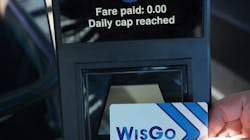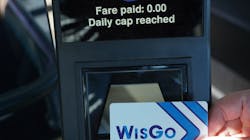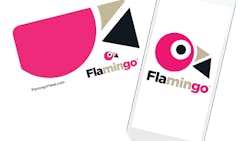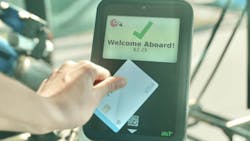The Future of Paying for Public Transit Will Bring Better Connections
Over the course of the 21st century, modern technology has changed the way we live, including the way transportation agencies collect fares.
Fare collection has been around for ages. Riders and advocates of public transportation are used to paying a fee to use services. The way they pay, however, has significantly changed over the past few years.
Fare capping has allowed agencies to charge a specific amount for different kinds of passes and trips but limits the amount of money a person can spend on a transit system per day, per week and per month. It allows the agency to collect revenue while giving all customers the ability to benefit from multi-use discounts but pay ride by ride.
In addition to fare capping, contactless payments have become popular among many transit agencies, especially since the start of the COVID-19 pandemic. The convenience of being able to swipe a card -- whether physically or digitally -- against a fare reader without physical contact in a quick and easy manner makes riding public transit hassle free for inexperienced or new riders.
Transit systems in Milwaukee, Wis., and the Tampa, Fla., area reflect the industry’s wider move toward payment systems that support equitable efforts, including fare capping, and provide for a more connected regional approach to fare collection.
MCTS’ WisGo and fare capping
In April, Milwaukee County Transit System (MCTS) in Wisconsin launched WisGo. Designed to make riding transit easier and accessible for everyone, WisGo allowed the implementation of fare capping for MTCS.
WisGo is currently in its introductory stage. MCTS has given customers until Sept. 30, to transition from the previously used M-Card system to WisGo. The program is supported through a contract with the Umo Mobility Platform by Cubic Transportation Systems.
According to MCTS Chief Financial Officer Tim Hosch, MCTS received offers from eight vendors before deciding on Umo.
“Deciding on a partner for this project wasn’t easy,” Hosch said. “We took our time with the interview process. We wanted to meet with their staff, really get to know them as a vendor because we’re trying to build this relationship over a 10-plus year period. We liked what Cubic brought to the table.”
Hosch adds partnering with Cubic Transportation Systems on WisGo allows MCTS to stand out from other transit agencies in Wisconsin.
“There are 15 transit agencies in Wisconsin trying to develop and manage their own fair collection systems, and they're doing it alone, so why not do it together and take Cubic, take advantage of the economies of scale, both economically and intellectually,” Hosch noted.
WisGo was initially set to launch in 2022, but it was pushed back until its April 1 launch day. The reason for the pushback according to Hosch: Supply chain issues.
“There were validator delays, which I think worked to our advantage because it allowed us a little more time in planning this out and getting everything scheduled and ready to go,” Hosch noted. “We switched to a different validator model that could be ready this spring, and we’ve been happy with the validator Umo has issued.”
Hosch explained the UMO validors pick up QR codes from six to seven inches away and have been well received by MCTS operators and riders.
MCTS implemented a new fare structure after the launch of WisGo, which includes:
- Regular fare rides — $2 per ride, with caps at $4 per day
- Reduced fare rides — $1 per ride, with a cap of $2 per day.
Under the previous MCTS system, riders would pay $2 for a single ride, $4 for a weekly pass or $19.50 for a monthly pass, with reduced fair at half the price for each package with no fare cap. MCTS also offered premium fair, creating numerous options for riders to choose from.
Hosch said WisGo creates clarity for riders.
“Before the implementation of WisGo, riders would, let’s say, buy a monthly pass, but if they were out of town for a lot of the month, the pass would go to waste,” Hosch stated. “WisGo strips that all away and now rides are $2, or $1 with reduced fare, and that's it, with fare capping taking care of the rest.”
Hosch explained the decision to begin capping fares was made to help everybody in Milwaukee ride public transit, regardless of income status.
“We're offering the old pass rates to everybody, regardless if riders are paying for it all upfront or if they're just paying $2 a tap, which is helpful for people in low income communities that maybe can only afford to put a little money on their card once a week, and that’s really easy to pitch to riders,” he said.
HART, PSTA, The Bus Contactless Payment System
In February, three transit agencies in the Tampa, Fla., area -- Hillsborough Transit Authority (HART), the Pinellas Suncoast Transit Authority (PSTA) and Hernando County Transit (The Bus) launched a first-of-its-kind regional contactless payment system in the state of Florida. Each ride costs $2, with a fare cap of $5 per day. Riders can pay for their fare through various payment methods, including Apple Pay, Google Pay and debit cards, as well as the Flamingo Fares smartcard or mobile app. Flamingo Fares allows a rider to use the same payment method across all three agencies.
Stephanie Rank, communications and public relations manager at PSTA, said all three transit agencies came together to create a uniform fare system across the Tampa Bay region.
“Before the rollout of this system, if riders were riding HART, they would have to pay HART’s fare. If they were riding Hernando, they would have to pay Hernando’s fare, and the same is true for [PSTA’s] fare, and that made it really hard for riders to keep track of how much money they have to spend on each agency,” Rank said.
Rank noted the system was in development for five years before launching, saying “a lot of testing with different cards and readers went into the development to ensure no hiccups at launch.”
Emmanuel Nunez, manager of retail sales and revenue at HART, says the feedback he’s received from HART riders has been overwhelmingly positive.
“The satisfaction from riders is about 98 percent since the system officially launched,” Nunez said. “We had a few one-offs early on where the system would charge a client $4 instead of $2, and it was a quick fix with vendors and no customers have complained about the system.”
HART also has its “Legacy System,” which is a paper card riders can purchase that is not a contactless card. Nunez explained while HART wants all of its riders to transition to contactless payments eventually, it knows there is still a market for the “Legacy System,” and they will not be discontinuing it anytime soon.
Even though the system has only been in operation for two months, Rank said PSTA is already seeing a boost in ridership, noting PSTA’s revenue increased by about $4,000 between February and March. Nunez noted ridership for HART is up five percent. Hernando County Public Information Coordinator Dominique Holmes noted The Bus has not seen an increase in ridership but pointed out The Bus’ ridership is significantly less than PSTA and HART, as it only covers the rural urban area of Tampa.
While PSTA is happy with its $2 fare price for its services, in the future, the agency is looking to implement a fare discount for its seniors across all payment methods.
“Right now, the discounted fare for seniors is only through the Flamingo Card, but that's the next phase of our contactless pay payment system,” Rank noted. “Right now, phase one is where you can use your Apple Pay, Google Pay Transit app, credit card, debit card, tappable card, but the next phase is getting that parameters where if you are a senior citizen or if you do need a discounted fair, and you qualify for a discounted fair, you'll be able to register your card and then automatically the next time you pay for a fair, it's discounted.”
On the topic of potentially going fare free across all PSTA’s modes like the agency has done with the SunRunner bus rapid transit system, Rank says it all comes down to funding.
“We would love to provide equitable free transit to everybody because it is a lifeline to a lot of people that use it to get to work, to get to medical appointments, to have freedom, but we need the proper funding to be able to do that. PSTA is one of the least funded transit agencies in the country, so we have to charge a fare to help with operating costs,” Rank said.
Nunez said the agencies will be looking to expand the contactless system in the future to more agencies.
“Everything depends on funding, but the system has the ability to incorporate additional agencies, so even though we could have agencies that could drop off because they have a particular vision that they want to accomplish, and they want to come back or new agencies want to come in, that could happen in the next few years,” Nunez said.
About the Author
Brandon Lewis
Associate Editor
Brandon Lewis is a recent graduate of Kent State University with a bachelor’s degree in journalism. Lewis is a former freelance editorial assistant at Vehicle Service Pros in Endeavor Business Media’s Vehicle Repair Group. Lewis brings his knowledge of web managing, copyediting and SEO practices to Mass Transit Magazine as an associate editor. He is also a co-host of the Infrastructure Technology Podcast.





